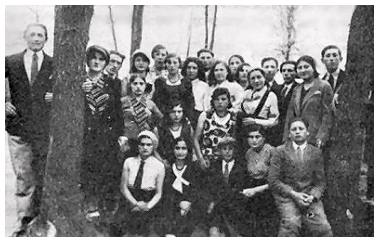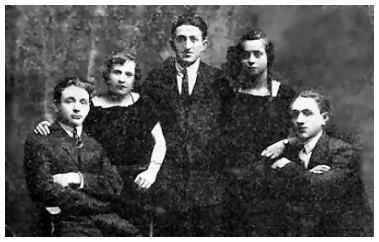 |
 |
|
[Pages 130-137]
52° 57' / 22° 22'
Jablonka My Shtetl
by Arie Wajsbord
Translated by Ada Holtzman z“l
From a distance the three streets resembles an eagle, and since nearby was the river “Raczka Jablon” (and from this derived the name of town Jablonka), the shtetl had the image of an eagle landing from the heights to drink fresh and pure waters.
According to the sources Jews came to Jablonka long time before their settlement in the beighbouring towns. Testimony of this fact is the old cemetry with the large trees which no more thicken and frozen they stand with their enourmous heads, like guards keeping the remains of Kosher Jews who buried in the Kever Israel (grave of Israel) for many generatins. In the Yizkor book of Lomza, Yom Tov Lewinski writes that when Zambrow, the town near Jablonka, was founded, the deceased of zambrow were buried in Jablonka, until the town grew bigger and with many efforts, the community of Zambrow got the permission to sanctify its own Jewish cemetery. In addition, it was the custom to arrange divorce ceremony in Jablonka, because it had the river running all the year, while in Wysokie it got dried in the summer time.
The estate of the Kulesze was on a few dunams, and considred as a holy site. This is because of a legend which passed from generation to generation in Jablonka, that in this place, on the old foundations of the old synagogue which was destroyed during WWI, a new holy site will be erected. And we, the children, dreamt and hoped to see the new synagogue with blue windows stand again, and pigeons, as the old people said, will sing their beautiful tunes once again.
The Jews of Jablonka were modest and hard laborers, who worked hard for their livelihood and were connected to the land from which they made their living. They fulfilled all their duties as citizens of Poland, and were totally devoted to the Zionist idea. We did not have revolutionaries and nor Epicureans. During a dry year the Jews of Jablonka prayed for rain and in over flooded year they prayed for bright blue skies.
Although it was a very small, our shtetl was blessed with intellectuals such as Bril and Szmule Slotka and Mendel Kroliwecki of blessed memory, the “doctor” who cured for free also Gentile people.
In Jablonka there were pioneer youth who went to Hachshara places (places of preparatory for immigration to Eretz Israel) and during years they prepared for immigration so that they weill be useful and constructive citizens in the Land of Israel. And there were young men in Jablonka, who, as there were no Yeshiva (Talmudic college) in town, wandered to far away Yeshivas all over Poland and Lithuania to study the Torah. When they returned to the shtetl, with the Zionist ideals penetrated into them, they spread the idea of the national revival in Eretz Israel among the youth and the adult people. They participated in public shows, participated in public ardent debates about subjects of paramount concern and sung the songs of Zion. Often the passionate arguments reached high tones, especially when orators from Poalei Zion and other parties came from Zambrow and Wysokie. Even though these verbal fights seemed so deep, it never was accompanied by any hostility to the opponent. As these debates were for heaven sake, and afterwards the opponents remained friend as before. Because everybody knew that even if the roads are different' they all lead to the same goal. Until today I remember the spiritual pleasure which we derived from sitting with our “Yeshiva” young men.
Jablonka was a distinguished Zionist shtetl. In every home you could find the blue box of Keren Kayemet Le'Israel (The Jewish National Fund), and during every event, funds were collected for Eretz Israel. Every cultural event with any income, part of it was allocated to the Keren Kayemet, and every bet or a vow, the money was donated to it or the Keren Hayesod – the Foundation Fund.
The economic life of the Jews of Jablonka resembled more the life style of a Moshav Ovdim (communal settlement in Eretz Israel) than the Jewish shtetl in Poland. Each Jew had a vegetable garden and also fruit trees. Nearly every family had a cow and everyday there was someone else who took the herd to the pasture and return it in the evening. The fee of the shepherd was paid collectively. When the time to collect potatoes arrived (since every Jew took care of having a cellar full of potatoes for the whole year, whether it was his own filed or leased one), the work was done collectively in turn. Everyday people were gathered at someone's field who prepared “Tluka” and together they filled tens of sacks with the collected potatoes.
Similar happening was in pulling feathers during the night following the Sabbath. This became a source of joy. In Jablonka nearly every family had an auxiliary farm, especially poultry: hens, ducks and goose. The goose and ducks were fattened and while they were fat enough, the Shochet, (ritual slaughterer) who was my uncle from Wysokie, was called to butcher them. The fat was melted during the long winter nights and the feathers were pulled and cushions and pillows their were filled with them. These pillows were given to young maidens as part of their dowry. Also filling the cushions was done together in good company. The housewife fried “latke”, pancakes with sugar and fritters were eaten without an end, each one as much as he liked. Often such a “tluka” ended by dawn.
These frequent gatherings inspired the shtetl with good atmosphere of family warmth. Everyone cared for his fellowship and was interested with his friend's well being and the whole shtetl seemed to be one big family.
Without artists and entertainers, our townspeople knew to rejoice and fill their lives with folkloristic hearty meaning. Take for example the Sabbath (Saturday) when they whole shtetl received a groom who came to visit his bride from another place. As soon as the prayer of Mussaf had ended, the children rushed, red were their faces from excitement, to bring the Cholent. By the end of the meal, they were sent with a bottle of liqueur to the house of the future father-in-law (only children were allowed to carry anything during the holy Sabbath). And in the house of the future father-in-law, tables were prepared with drinks and refreshments: fruits, hazelnuts and sweets from Eretz Israel…
During the evening, all those who sent drinks to the house of the future father-in-law gathered and around led tables greeting and wishes were said to the engaged couple and their parents. People ate, drunk, sung and recited poems and prayers and everybody participated in their fellowman's happiness. These fests contributed a lot to the success of the matchmaking than the dowry.
Also secular days were full of joy and festivities. While our dramatic circle showed a play, many visitors from Zambrow and Wysokie, Wizna and Kulesze Koscielne and all the neighboring small villages where Jews lived came to see it and enjoyed the opportunity of meeting of other Jews from other shtetls.
Gone is Jewish Jablonka. Our little shtetl was erased off the earth like hundreds of other communities in Europe. After the War I had sent a letter of inquiry to Mr. Zaloski, my Polish teacher. He wrote to me that the Jews of Jablonka stayed for a short time in ghetto Wysokie, and together with the Jews of Zambrow they were deported and perished in Auschwitz. From the Polish population, the teacher Jazombek and the policeman Bagonski were killed.
After the receipt of this letter, my last hope ended. There are no more Jews in Jablonka. Father perished, Mother perished, brothers and sister perished. The cruel enemy murdered them all – people, women, children. And a frightful cry emersed from the depth of the heart: W H Y?!
|
|
|||
| The Jewish youth in Jablonka | The library Committee in Jablonka |
|
JewishGen, Inc. makes no representations regarding the accuracy of
the translation. The reader may wish to refer to the original material
for verification.
JewishGen is not responsible for inaccuracies or omissions in the original work and cannot rewrite or edit the text to correct inaccuracies and/or omissions.
Our mission is to produce a translation of the original work and we cannot verify the accuracy of statements or alter facts cited.
 Wysokie-Mazowieckie, Poland
Wysokie-Mazowieckie, Poland
 Yizkor Book Project
Yizkor Book Project
 JewishGen Home Page
JewishGen Home Page
Copyright © 1999-2025 by JewishGen, Inc.
Updated 25 Mar 2021 by JH